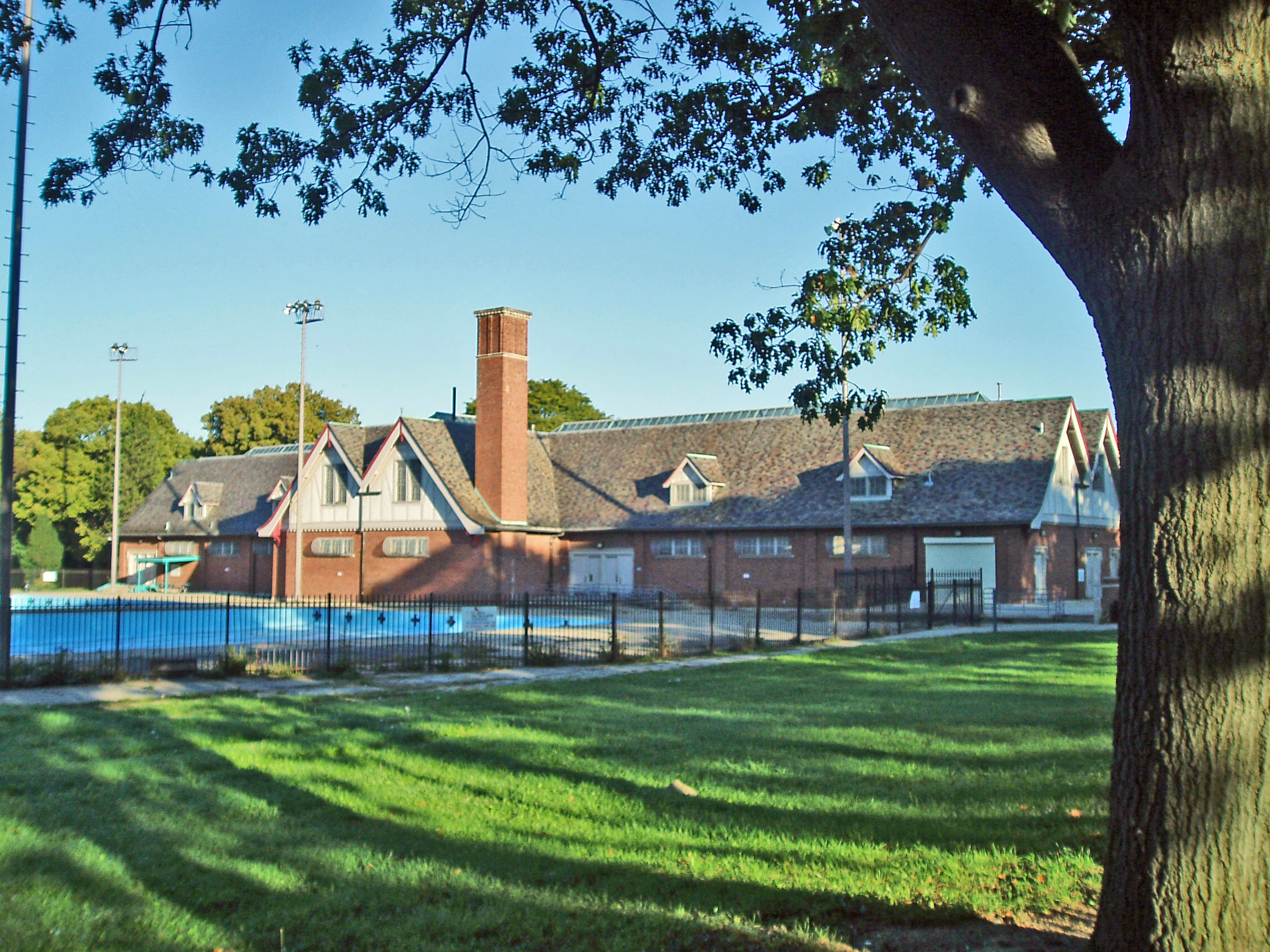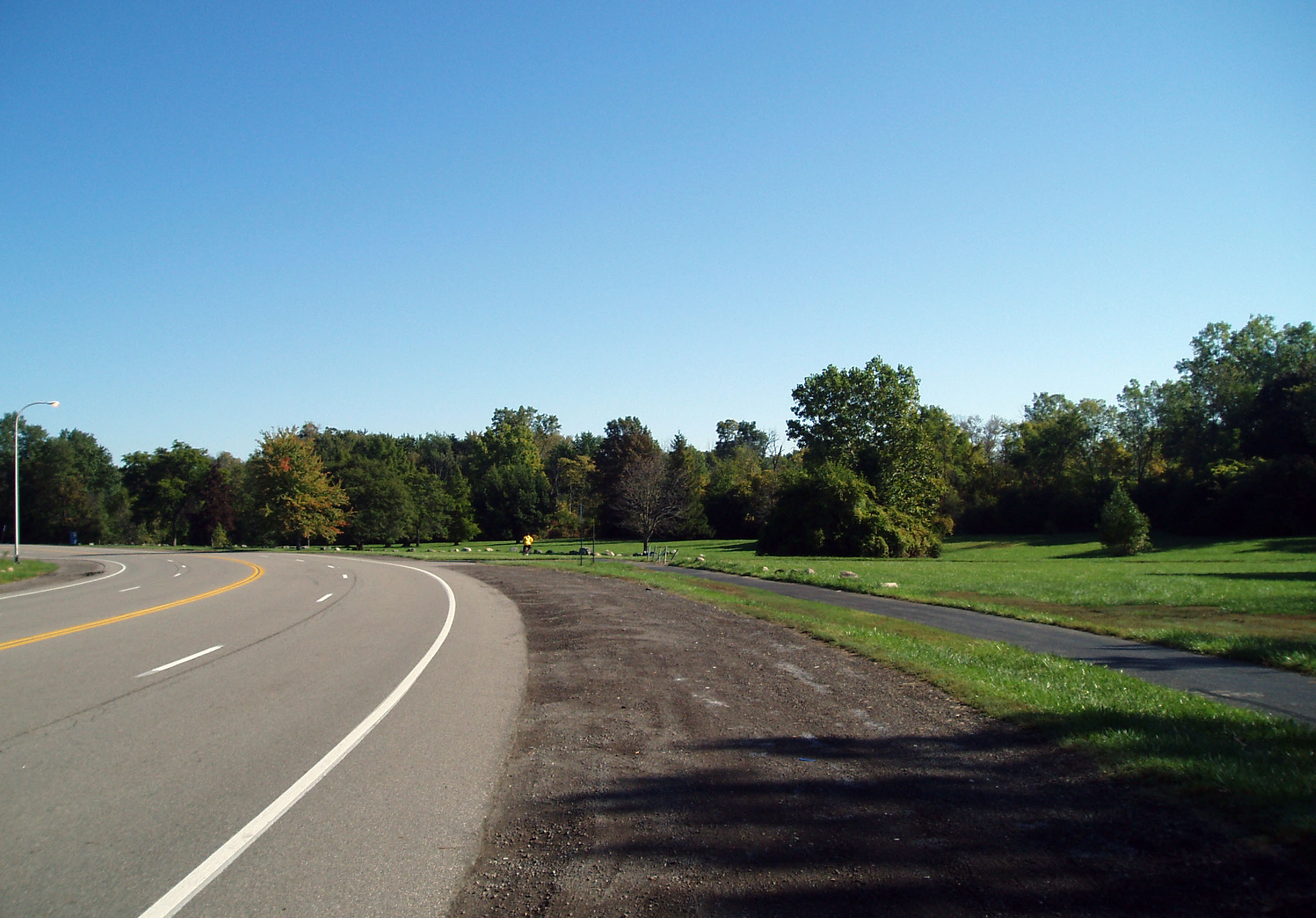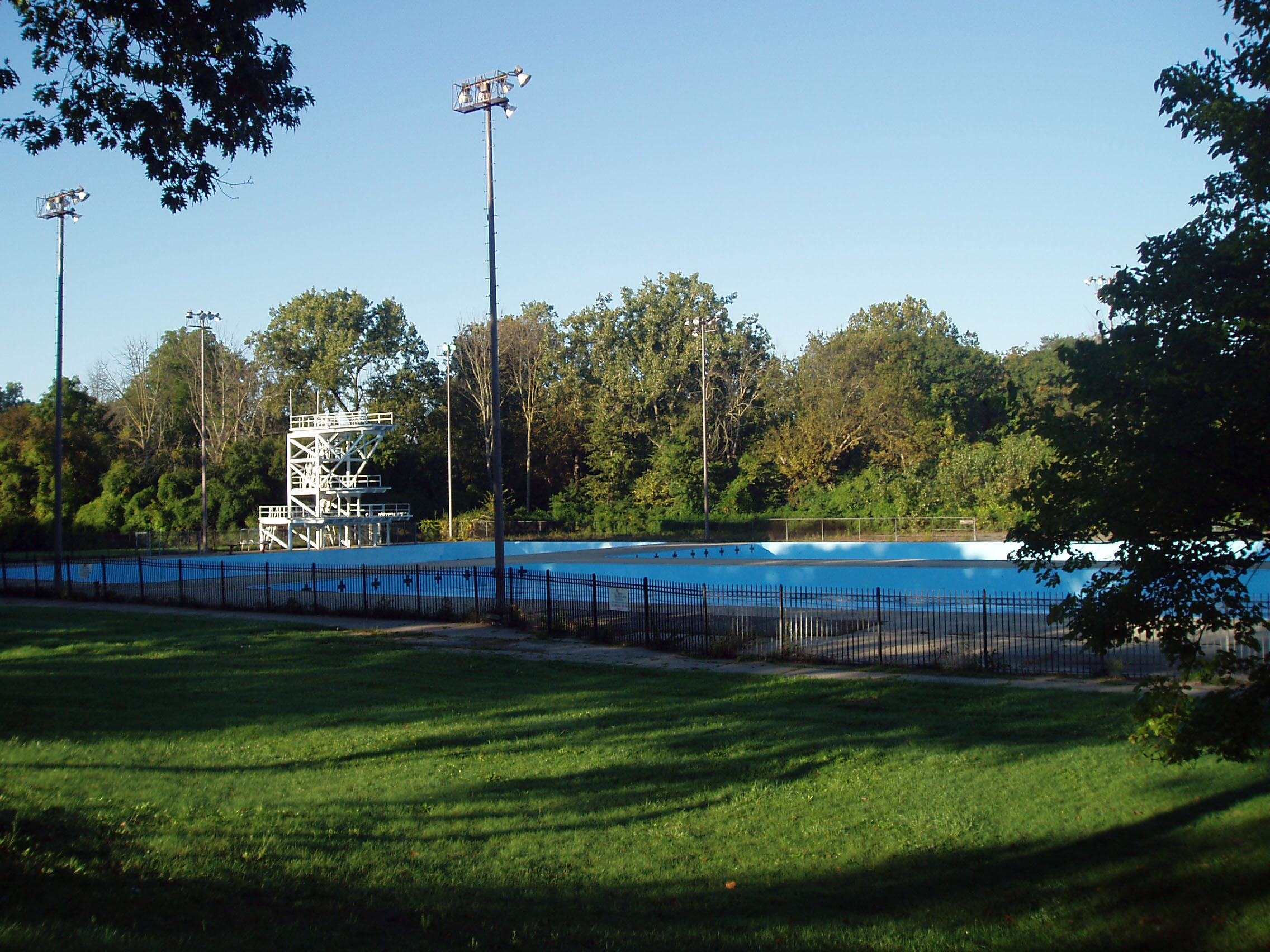

This is one of the most attractive but least
well-known large urban parks in a major American city. In the 1920s, the
City of Detroit paid $1.3
million
to purchase land from six farmers at the western edge of the city to be used
for River Rouge Park. It now contains 1,184 acres, which means that it is 40
percent larger than New York City’s Central Park. The Rouge River flows
for more  than two miles through this green and lovely park. At least 15 acres
have been restored to native prairie. This park contains of an 18-hole golf
course, 14 regulation diamonds, including the Hank Aaron and Aurelio Rodriguez
baseball
fields, 12 playgrounds, 11 tennis courts, eight miles of bicycle trails, including
one used by the Michigan Mountain Biking Association, 200 picnic tables, a
driving range, an area for scout groups to camp and the large Alex Jefferson
Model Airplane Field. The Brennon Pools are a major feature. There are two
Olympic-sized pools side by side and a smaller pool. This athletic facility is located
near the intersection of Plymouth and Outer Drive.
than two miles through this green and lovely park. At least 15 acres
have been restored to native prairie. This park contains of an 18-hole golf
course, 14 regulation diamonds, including the Hank Aaron and Aurelio Rodriguez
baseball
fields, 12 playgrounds, 11 tennis courts, eight miles of bicycle trails, including
one used by the Michigan Mountain Biking Association, 200 picnic tables, a
driving range, an area for scout groups to camp and the large Alex Jefferson
Model Airplane Field. The Brennon Pools are a major feature. There are two
Olympic-sized pools side by side and a smaller pool. This athletic facility is located
near the intersection of Plymouth and Outer Drive.
Compared to many urban parks, this one is
rather underdeveloped. There are few statues or sculptures. The police station
is a modest, functional
building.
Indeed, there are few, if any, architecturally significant buildings named
for the donor. I infer that the City of Detroit began to build this park
in the
1920s, but then the Depression of the 1930s precluded the city making investments
in the 1,184 acres. During the early 1940s, the Arsenal of Democracy devoted
its efforts to winning World War II. Then, after the war, the city’s
population began to decline and issues other than park development took center
stage. Fortunately, there is now an active Friends of Rouge Park organization
promoting the development of this potentially great urban park. Information
is available from the website listed below.
One of the incidents that led to the Detroit riot of July, 1967 occurred in River Rouge Park. Three events during that summer were widely discussed and highly significant in Detroit’s black community, but hardly mentioned by the city’s media. Each event was interpreted by many blacks as convincing evidence of the area’s pervasive white racism and the complicity of the criminal justice system, especially the police. In June, 1967, a black man, Carado Bailey, who was married to a white wife, moved into a neighborhood in suburban Warren. On June 12, a crowd of 80 to 100 whites surrounded the Bailey home, shouted obscenities and threw a smoke bomb. For three nights, crowds of whites circled the residence. Warren police finally sealed off a four block area around the Bailey’s home. Civil rights leaders in Detroit charged that Warren police officers incited and abetted the racial disturbance, a claim many Detroit African Americans believed.
Many in Detroit’s black community did not trust the police and cited numerous examples of officers needlessly killing African-Americans. Theodore Spicher was a policeman who blacks thought was exceptionally cruel to their race. In July, 1963; he claimed that he saw Cynthia Scott—a commercial sex worker well known in the black community with the street name of Saint Cynthia —walking along John R. with money in her hand. Spicher stopped Scott and attempted to arrest her, assuming that she had rolled a client and taken money from his wallet. Officer Spicher contended that not only did Cynthia Scott resist arrest, but that she started slashing him with a knife and then tried to flee. Officer Spicher shot Cynthia Scott twice in the back as she ran away. The shots slowed her but when Officer Spicher approached her, he claimed that she once again tried to slash him so he issued a fatal shot to her stomach. Detroit’s Civil Right leaders made this killing into a major issue. Many blacks assumed that Officer Spicher was shaking down Cynthia Scott who resisted turning her hard-earned money over to the police. They believed that Spicher and Scott argued, and then as Scott walked away, Spicher shot her in the back. Civil rights leaders demanded an investigation, but whites wondered why Detroit’s African Americas would be so concerned about the shooting death of a black prostitute. Indeed, some in the white community derisively described her as Saint Cynthia. The prosecutor quickly exonerated Officer Spicher and called the killing justified. Black leaders requested that Detroit’s two black members of Congress—Charles Diggs and John Conyers who continues to serve a half century later—demand an investigation. However, the prosecutor’s decision about the appropriateness of Officer Spicher’s killing Cynthia Scott stood. The killing of Scott symbolized to blacks how the police treated the city’s African Americans.
On July 1, 1967, Vivian Williams—another black commercial sex worker—was shot and killed at the corner of Twelfth Street and Hazelwood. This location was only three blocks from where that summer’s tragic riot began on July 22. There were two radically—and racially—different stories about her death. Police Chief Ray Girardin issued the official version; namely, that Vivian Williams had been shot to death by her pimp. Many blacks believed a different story and cited evidence that some found convincing. They believed that on June 29, a white policemen attempted to arrest Vivian Williams but she pulled a knife on the officer and cut him. Two nights later, they believed, the officer returned, and in retribution, shot Vivian Williams to death. This incident quickly reminded many blacks about the killing of Cynthia Scott four summers earlier.
The third incident happened in River Rouge
Park. In 1967, the neighborhoods surrounding were home to almost exclusively
white residents.
Apparently, the
Jim Crow norms  of that era defined River Rouge Park as a white park, and blacks
who visited it could expect to be harassed by white youth. On June 23, 1967,
a black Vietnam veteran, his wife and another black couple went to the park
to enjoy themselves. Not surprisingly, they were harassed, were accused of
playing music too loudly and then a white bystander suggested that the white
youths should “kill all niggers.” The Thomases and the other black
couple left the park, but for some reason, the Thomases returned after midnight.
A group of whites recognized them and began harassing them, including a threat
to rape Mrs. Thomas. At this point, the Thomases decided to leave River Rouge
Park but they could not start their car since someone had disconnected the
battery. The Thomases then sought refugee in the park’s recreation building,
but the caretaker working that night—a black man—refused to
open the door for them, claiming that it was against regulations. Mrs. Thomas
apparently begged on her knees, but the attendant enforced the rules. White
youth then began throwing missiles at Mr. and Mrs. Thomas. At one point,
Mr. Thomas approached the whites to plead for mercy but he was jumped. He eventually
broke free and ran away, but three shots rang out and he was killed instantly.
The events led Mrs. Thomas to miscarry. The police arrested Michael W. Palchlopek
for the murder. Five of his compatriots were also arrested, but were released
almost immediately, apparently because Mrs. Thomas could not identify them
in a line-up.
of that era defined River Rouge Park as a white park, and blacks
who visited it could expect to be harassed by white youth. On June 23, 1967,
a black Vietnam veteran, his wife and another black couple went to the park
to enjoy themselves. Not surprisingly, they were harassed, were accused of
playing music too loudly and then a white bystander suggested that the white
youths should “kill all niggers.” The Thomases and the other black
couple left the park, but for some reason, the Thomases returned after midnight.
A group of whites recognized them and began harassing them, including a threat
to rape Mrs. Thomas. At this point, the Thomases decided to leave River Rouge
Park but they could not start their car since someone had disconnected the
battery. The Thomases then sought refugee in the park’s recreation building,
but the caretaker working that night—a black man—refused to
open the door for them, claiming that it was against regulations. Mrs. Thomas
apparently begged on her knees, but the attendant enforced the rules. White
youth then began throwing missiles at Mr. and Mrs. Thomas. At one point,
Mr. Thomas approached the whites to plead for mercy but he was jumped. He eventually
broke free and ran away, but three shots rang out and he was killed instantly.
The events led Mrs. Thomas to miscarry. The police arrested Michael W. Palchlopek
for the murder. Five of his compatriots were also arrested, but were released
almost immediately, apparently because Mrs. Thomas could not identify them
in a line-up.
Many in the black community assumed that the killing of Mr. Thomas was another example of racism in Detroit and the lax way prosecutors sought to punish whites who killed blacks. They predicted that Michael Palchlopek would not serve time for the River Rouge Park murder of Mr. Thomas. They were correct. Seventeen months later a jury found him not guilty.
There is no way to specifically assess how these three violent incidents in the summer of 1967 led to the racial riots. Those who described the history of the riot—especially Sidney Fine who wrote the definitive history, Violence in the4 Model City: The Cavanagh Administration, Race Relations, and the Detroit Riot of 1967 (University of Michigan Press, 1989)—stress their importance.
River Rouge pools had another roll in the history of the city. The 1956 United States' tryouts for the Olympic team were held here in the pools that Albert Kahn designed in the 1920. The city of Detroit sought to host the 1968 summer Olympics. There was a very spirited and sometimes hostile competition between Detroit and Los Angeles since the U. S. Olympic Committee could nominate only one potential host city. Detroit won that competition. In the summer of 1963, the International Olympic group met in Germany to select the host city for the 1968 competition. Four cities sought the award: Buneos Aries, Detroit, Lyon and Mexico City. When the final vote was taken, Detroit lost to Mexico City by one vote. Planners for the 1968 Olympics in Detroit considered using the River Rouge pools for the competition but then the issue became mute. So far as I know there is no one book covering the great amount of planning that Detroit did for the 1968 Olympics and their heart-breaking loss to Mexico City. However, the topic is extensively covered in Chapter 16 of Once a Great City: A Detroit Story by David Maraniss. (New York: Simon and Schuster, 2015)
As the city sunk into debt in the Twentieth First Century, it could no longer afford to maintain these great pools. They were abandoned by the city in 2010. In 2014, the Michigan state legislature and the Lear Corporation appropriated funds to restore the pool to their glory. In the summer of 2014, the restored pools were officially opened when the Republican leader of the state senate jumped into the pools to symbolize some of a revival for this great park in Detroit.
Perhaps the best days of River Rouge Park are yet to come. With modest investments, it could be an attractive green space and recreational area anchoring attractive neighborhoods in the west side of Detroit, Redford Township and Dearborn Heights. Presumably, no architect designed a wider variety of structures in Detroit than did Albert Kahn. So far as I know, there are the only outdoor pools that he designed. He did, I presume, design the indoor pool at the Detroit Athletic Club.
Clubhouse and pools: 1920s
Architect: Albert Kahn
City of Detroit Designated Historic District: Not listed
State of Michigan Registry of Historic Places: Not listed
National Register of Historic Sites: Not listed
Website: www.rougepark.org
Use in 2015: Municipal park
Photograph: Ren Farley; October 5, 2008
Description updated: December, 2015
Return to Parks and Sports Venues